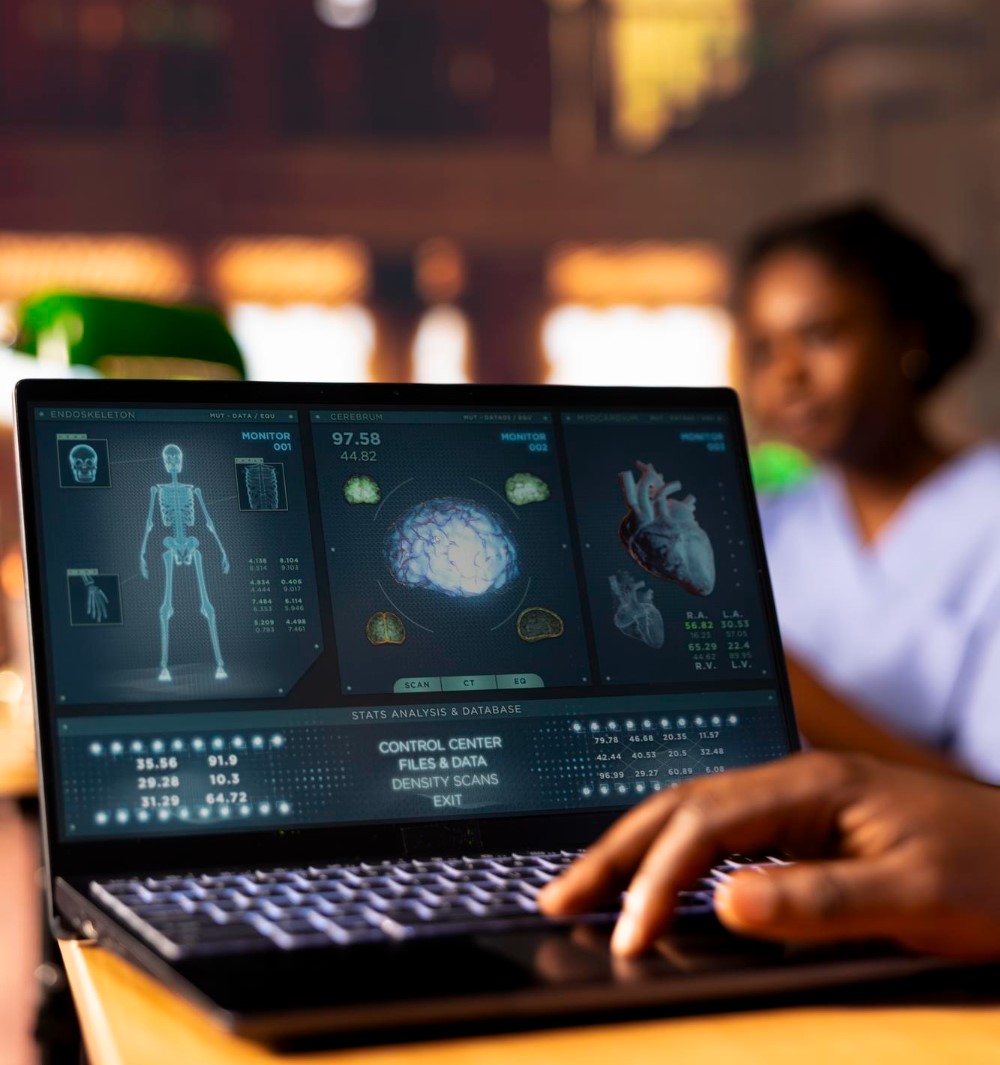
Discover how telemedicine, EMR, billing, insurance, and logistics can merge into one seamless digital healthcare ecosystem, unlocking sustainable ROI for clinics worldwide.
Healthcare has entered a turning point. No longer defined by brick-and-mortar visits alone, modern medicine is evolving into a borderless, technology-driven ecosystem. Patients are increasingly expecting care that flows effortlessly; from their first consultation to ongoing management, billing, insurance, pharmacy delivery, and beyond. This shift is not just a technological evolution; it’s a fundamental reimagining of what healthcare means in a digitally connected world.
The next stage of digital health transformation lies in true interoperability: a connected ecosystem where technology drives clinical outcomes, operational efficiency, and measurable financial returns.
This is particularly critical for health systems in emerging markets such as Nigeria, where healthcare accessibility gaps and infrastructure limitations have accelerated the demand for scalable digital health solutions. Yet the same principles apply globally, clinics all over the world face the same challenge: building an integrated healthcare experience that meets patient expectations while delivering strong ROI.
A properly structured digital ecosystem rather than being viewed as a nice to have innovation, is the foundation for sustainable healthcare delivery in a world where remote care, insurance claims, electronic records, and logistics must coexist in a single, intelligent flow.
The Vision of a Connected Digital Health Ecosystem
A true end-to-end healthcare ecosystem is more than a collection of tools. It is a strategically orchestrated network where data communication, and operational workflows move without friction. At its core, it involves four critical elements:
- Telemedicine and virtual care to eliminate barriers of distance and time.
- Electronic Medical Records (EMR) to store and share patient information securely.
- Billing, insurance, and payment systems to make care financially seamless.
- Logistics and delivery networks to ensure that prescriptions, lab services, and follow-up care reach patients efficiently.
What makes this vision powerful is the continuity of care. A patient scheduling a teleconsultation, speaking to a physician, receiving an e-prescription, paying through a secure billing interface, and having their medication delivered to their doorstep, all without ever leaving a single digital platform, is the foundation of modern care.
Certain reports indicate that digital health ecosystems improve access, reduce administrative burden, and enhance outcomes, particularly in underserved regions. And for clinics, the benefits go beyond better care, they translate into improved operational margins, better patient retention, and sustainable financial performance.
Telemedicine: The Core of Modern Healthcare Ecosystems
Telemedicine is the front door to the new patient journey. It is often the first interaction patients have with a healthcare provider in a digital environment. By enabling real-time consultations, follow-ups, and triage, telemedicine helps extend reach, reduce wait times, improve operations and increase patient satisfaction.
Clinics that adopt telemedicine strategically are expanding services and in addition, they’re building scalable systems that unlock new revenue streams. A single platform can host hundreds of consultations per day without the spatial and operational limitations of physical clinics.
Telemedicine also enables clinical flexibility. Specialists can collaborate remotely, patients can receive second opinions without traveling, and follow-ups can be done asynchronously, all contributing to a more efficient healthcare delivery model.
This also has powerful implications for return on investment (ROI). Reduced no-shows, lower infrastructure costs, better time utilization for physicians, and higher patient throughput are direct financial outcomes. The more efficiently a clinic uses telemedicine, the stronger its cost-benefit ratio becomes.
Beyond the economics, telemedicine supports continuity of care, which improves patient adherence to treatment and increases trust in providers. When patients experience frictionless consultations and reliable follow-up, they are far more likely to remain loyal to that healthcare brand. In competitive health markets, trust and retention are major growth drivers.
Telemedicine is also supported by a rapidly evolving policy and regulatory landscape. Governments and health systems across continents are encouraging digital health adoption through frameworks that ensure patient safety and data protection. The U.S. Centers for Medicare & Medicaid Services expanded telehealth reimbursements; the European Commission supports cross-border e-health services; and Nigeria is also moving toward formal digital health regulation, encouraging providers to adopt secure and scalable platforms.
EMR Integration, Billing Systems, and Logistics in a Connected Healthcare Flow
EMR Integration: Building the Backbone of Digital Care
If telemedicine is the front door of modern care, then Electronic Medical Records (EMR) are the central nervous system. EMR platforms hold the complete story of a patient’s health journey; every consultation, diagnosis, prescription, lab result, and follow-up note is stored in a structured, and secure format.
For decades, healthcare systems relied on paper-based records and disconnected data silos that slowed down care delivery and increased the risk of errors. But in a world where care must move fast, that model is no longer sustainable. EMR integration ensures that every stakeholder operates with the same real-time information.
This seamless data exchange leads to more accurate clinical decisions, fewer duplicate tests, reduced administrative work, and better overall outcomes.
According to HealthIT.gov, integrated EMR systems improve coordination, reduce errors, and increase revenue through better coding and billing accuracy. Clinics that implement these systems strategically experience faster claim approvals, fewer reimbursement delays, and less paperwork; freeing staff to focus on patient care rather than administrative bottlenecks.
In countries like Nigeria, where patient data is often fragmented, EMR integration plays an even more critical role. Instead of each hospital or clinic maintaining isolated records, shared platforms allow care continuity across facilities and regions, improving efficiency and reducing costs. The same principle applies globally, a connected EMR ecosystem ensures care flows logically and securely.
This is all about transforming the way clinics operate. When physicians, labs, pharmacies, and insurers are connected through a common data language, care becomes smarter, faster, and more profitable.
Billing and Insurance Integration: Making Care Financially Seamless
One of the most overlooked but crucial components of a connected healthcare ecosystem is billing and insurance integration. No matter how advanced the clinical technology may be, the financial experience can either strengthen or break patient trust.
Historically, patients had to navigate multiple systems: separate portals for payment, insurance claim forms, delayed invoices, and inconsistent pricing. For providers, this often meant delayed revenue cycles, administrative headaches operational mishaps, and cash flow challenges.
A properly integrated billing system solves this problem by automating financial processes. Patients can make secure payments during or after teleconsultations, receive clear invoices, and track insurance claims within the same platform. Clinics benefit from faster reimbursements, lower error rates, and predictable revenue streams.
McKinsey & Company has consistently highlighted how digital payment and billing systems reduce operational costs while improving patient satisfaction. When patients understand their bills, and have multiple secure payment options, they are more likely to complete care cycles and return for follow-up visits.
Insurance integration is equally important. In many countries, insurance approvals can delay care and frustrate patients, thereby creating unnecessary backlogs. By connecting telemedicine, EMR, and insurance platforms, clinics can automatically verify coverage, submit claims, and receive payments without manual intervention.
For Nigerian clinics and hospitals, where insurance penetration is growing, this reduces dependence on manual claim processing and helps build financially sustainable care models. For international providers, it aligns with global best practices in revenue cycle management.
Ultimately, integrating billing and insurance is a strategic enabler of ROI. Faster payments mean stronger cash flow, better operational planning, and more capacity to reinvest in patient care.
Logistics Integration: Closing the Loop on Patient Experience
Telemedicine and EMR may bring patients into the ecosystem, but logistics closes the loop. After consultations, patients often need prescriptions delivered, lab samples collected, or home-based care coordinated. Without logistics integration, even the most advanced telehealth platform can feel incomplete.
A logistics-enabled digital health ecosystem ensures that after a doctor prescribes medication, the patient can seamlessly receive it at their doorstep through verified pharmacy partners. Lab requests are automatically routed to accredited labs, and results flow back into the EMR, creating a full circle of care.
This not only improves patient adherence and satisfaction but also creates new revenue opportunities for clinics. For example:
Home delivery of prescriptions builds patient loyalty.
Integrated lab partnerships create shared revenue streams.
Automated follow-up scheduling increases consultation frequency.
Internationally, logistics is equally vital. Even in advanced economies, patients increasingly expect on-demand healthcare experiences — similar to e-commerce delivery models. A healthcare provider that connects clinical care, financial transactions, and physical service delivery stands out as both efficient and patient-centric.
A seamless logistics layer transforms digital healthcare from being just a consultation tool to a complete service ecosystem. And that’s where ROI becomes tangible. Every extra touchpoint; prescription delivery, chronic disease monitoring, adds both value to the patient and revenue potential for the clinic.
The Power of Integration
The true strength of telemedicine, EMR, billing, and logistics lies not in their individual capabilities but in how they work together. A clinic that adopts these systems separately gains efficiency. But a clinic that integrates them into one unified digital flow gains scalability, financial predictability, brand strength and also efficiency.
This is why health technology platforms are investing heavily in building interoperable solutions that fit local realities while aligning with global healthcare standards. The future belongs to clinics that understand that technology is a strategic engine of growth.
Interoperability, AI, ROI, and the Future of Digital Healthcare
Interoperability: The Glue That Holds the Ecosystem Together
A healthcare ecosystem can only achieve its full potential if its components communicate seamlessly. Interoperability; the ability of different digital systems and platforms to exchange and use health data, is the critical enabler of everything we’ve discussed so far.
Telemedicine without EMR integration creates fragmented care. EMR without billing creates administrative delays. Logistics without data sharing creates gaps in treatment. Interoperability ties all these components together into one coherent system where information flows securely and efficiently.
The U.S. Office of the National Coordinator for Health Information Technology defines interoperability as the ability to exchange health information “without special effort on the part of the user.” That’s exactly the vision forward-looking clinics need to embrace:
True interoperability creates:
- Operational efficiency, by eliminating manual data entry and repetitive tasks.
- Clinical accuracy, by ensuring that every decision is based on the most updated records.
- Regulatory compliance, as data security and privacy are easier to enforce in structured systems.
- Patient trust, because information is consistent and accessible across the care journey.
In practical terms, interoperability means a teleconsultation note automatically updates the EMR, generates a billing code, verifies insurance, triggers logistics for prescription delivery, and records the event in a compliance-ready format. All of this happens in the background, without the patient needing to repeat information or staff needing to manually coordinate steps.
Globally, interoperability is becoming a standard requirement. Clinics that align with these standards will be best positioned to thrive in an increasingly digital health economy.
AI and Data: The Intelligence Layer of Digital Health
While telemedicine, EMR, billing, and logistics form the structure, artificial intelligence (AI) and data analytics bring the intelligence that makes the system adaptive, predictive, and truly transformative.
Healthcare providers now collect vast amounts of data: patient demographics, clinical records, lab results, claims, prescription histories, logistics patterns, and more. AI turns this raw data into actionable insights, helping clinics make smarter decisions at every level of care delivery.
For example, predictive analytics can help providers identify high-risk patients and intervene earlier, reducing hospitalizations and costs. AI-powered triage tools can guide patients to the right level of care, improving efficiency. Revenue cycle analytics can flag billing errors or delays before they impact cash flow.
World Health Organization and OECD emphasize that AI in healthcare improves clinical outcomes, reduces errors, and lowers operational costs when deployed responsibly.
For Nigeria and other emerging markets, AI can help bridge human resource gaps. A clinic with limited specialists can use AI-driven decision support tools to ensure consistency and accuracy in care delivery. Globally, AI is already transforming patient engagement, diagnostics, and remote monitoring; creating what many call intelligent health systems.
Importantly, AI is amplifying human clinicians' capacity more than replacing them, and helping them make better decisions faster, and ensuring that care remains both personalized and scalable. When combined with interoperable systems, AI becomes a powerful enabler of ROI.
Measuring ROI in an Integrated Digital Health Ecosystem
Return on investment (ROI) is not just a financial concept in healthcare; it is a strategic performance indicator. Clinics and hospitals investing in digital health systems want to know if this transformation does pay off.
The answer lies in measurable metrics. A well-designed digital ecosystem delivers tangible financial, operational, and clinical returns, including:
- Reduced operational costs: Lower overhead from fewer physical visits, smaller front-desk staff, automated billing, and less paperwork.
- Increased patient volume: Telemedicine expands reach beyond physical boundaries, increasing daily consultation capacity.
- Shorter revenue cycles: Integrated billing and insurance reduce delays in claim processing.
- Improved patient retention: Seamless logistics and follow-ups encourage repeat visits.
- Enhanced staff productivity: Automation reduces burnout and frees up time for higher-value tasks.
The Future of Digital Healthcare: A Unified Patient Journey
The trajectory of healthcare is clear: from fragmentation to integration, from isolated interactions to unbroken patient journeys. Soon, patients will expect healthcare to function like other digital services; smooth, fast, efficient and personal. They won’t tolerate filling out the same form multiple times or waiting weeks for results that could be shared instantly.
The global healthcare sector is moving toward platform-based care, where a single digital backbone connects multiple service layers: consultations, diagnostics, billing, insurance, logistics, and long-term care management.
Emerging technologies like 5G, wearables, and remote monitoring will deepen this integration. A patient could have a teleconsultation, upload wearable data, receive an AI-assisted treatment plan, and get medications delivered, all in one continuous flow.
This vision is not limited to developed economies. It is especially relevant in countries like Nigeria, where digital infrastructure is growing rapidly and traditional healthcare access is still limited in many areas. By embracing integrated ecosystems early, providers can leap ahead of global competitors.
However, building such ecosystems requires strategic investment. It’s not about purchasing one tool at a time but designing an interoperable foundation that scales as demand grows. That’s where purpose-built health technology platforms become essential partners.
Why Delon Health Is Positioned to Power This Future
Unlike fragmented point solutions, Delon Health focuses on creating end-to-end interoperability, allowing telemedicine, EMR, billing, insurance, logistics, and AI to work as one unified system.
As healthcare accelerates into the digital era, the organizations that will lead are those capable of turning fragmented systems into cohesive, intelligent ecosystems. .
By unifying telemedicine, EMR, billing, insurance, logistics, AI, and compliance into one platform, it enables healthcare organizations to scale faster, operate smarter, and deliver better care.
Visit Delon Health to discover how we help connect the entire patient journey from consultation to continuity. From specialized support for unique practice types to comprehensive billing solutions, we ensure your technology choices support both better patient care and stronger financial results.








